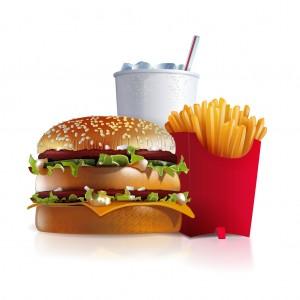At a recent meeting of the Obesity Society Jason Block, MD, of Harvard Medical School and fellow researchers reported that parents often underestimate the calories their school-age kids are consuming when they eat large meals at fast food restaurants.
 According to the study, the average meal purchased in four New England cities contained 733 calories, and 21% contained more than 1,000 calories, But the parents estimated an average of only 562 calories per meal, with 72% underestimating the actual content. “There was an association between larger meals and larger underestimations, which may hold some promise for menu labeling,” Dr. Block said. He noted that the Affordable Care Act (ACA) mandates that restaurants with 20 or more locations nationwide post calorie information on their menus.
According to the study, the average meal purchased in four New England cities contained 733 calories, and 21% contained more than 1,000 calories, But the parents estimated an average of only 562 calories per meal, with 72% underestimating the actual content. “There was an association between larger meals and larger underestimations, which may hold some promise for menu labeling,” Dr. Block said. He noted that the Affordable Care Act (ACA) mandates that restaurants with 20 or more locations nationwide post calorie information on their menus.
The researchers found that only 15% of parents saw nutritional information in the restaurants and fewer still (4%) used that information when ordering. “So they may not use it even if it’s more accessible,” Block stated.
Last year at the society’s annual meeting, Dr Block reported that 80% of adolescents in Boston, Springfield, Mass., Providence, R.I., and Hartford, Conn., underestimated the amount of calories their fast food meals contained and 86% did not notice any nutritional information in the restaurants.
In the current study, Block and his colleagues visited 10 restaurants in each of the four cities… three McDonald’s, three Burger King, two Subway, one KFC, and one Wendy’s. Each restaurant was visited six times at dinnertime.
Those participating in the study included parents or legal guardians of children and teens, ages 3 to 15 (mean age 7.9). The analysis included 330 families, representing 45% of those who were approached.
Most of the children (57%) were overweight or obese. The sample was ethnically diverse — 33% black, 30% Hispanic, 19% white, 3% Asian, and 15% other or multiracial.
The researchers collected receipts when the parents left the restaurants and administered a short survey about the calorie content of the meal and awareness and use of the nutritional information. The actual calorie content of the meals was calculated using the receipts and information on the restaurants’ websites.
Many of the parents purchased large meals for their children and most underestimated the calorie content. Nearly one-quarter (24%) underestimated the calorie count by at least 500.
Those who underestimated the daily requirement tended to also underestimate the calories in a meal, a finding that “supports an anchoring statement on menus,” Block said. The federal regulations require that, in addition to calorie information, menus must include an anchoring statement describing the typical daily calorie requirement.
The study was funded by the National Heart, Lung, and Blood Institute and by a Robert Wood Johnson Foundation Health and Society Scholars Seed Grant.
Source: The Obesity Society

